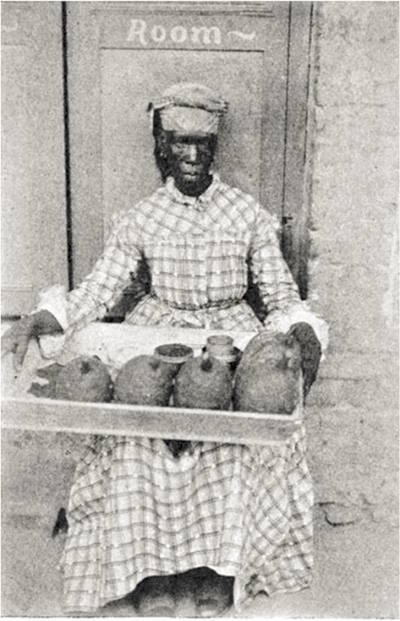|
A marchande of 1910 selling breadfruit from a wooden tray. “Poisson frais, poisson, poisson ..fressh feesh!” This would be the chant of the fish vendor while the mists still lay on the green hills overlooking the Port-of-Spain of the 19th and early 20th centuries. Those were the days of the marchandes, or vendors, who brought the means of sustenance to many homes in the city.
The establishments of the white and coloured elites, in their fine residences around the Savannah, could afford a cook whose duties began at 5 am, heading to the Eastern Market on Charlotte Street to purchase meat, fish and vegetables for the daily meals. Those who could not make the trek to market preferred to wait on the marchandes, who with unflagging certainty would present themselves at the front gate (or the pantry door of the homes of gentility, where they would not be permitted to walk up to the front door). In addition to the fish vendor, there would be purveyors of fowls called marchande poule selling trussed-up live chickens. The fruit of the land would also be sold from wooden trays—peewah, topi tambo, pois doux and other natural treats. Speaking of treats, there would also be marchandes who were favourites of the children, since their goods would be of a more toothsome nature, comprising coveti pocham (a large ginger biscuit resembling a chamber-pot cover, hence its name), lavanie (miscellaneous sugar sweets), toolum, sugar cakes and tambran balls. Starch cakes for washing would also be among the stock in trade of the marchandes. The marchandes themselves would be a sight to behold in their voluminous dresses, with Martiniquen head-kerchiefs knotted around their heads most picturesquely. For all their cheery appearances, the marchandes generally had hard lives, few earning enough to purchase a tiny cottage in Belmont or Laventille to accommodate their old ages. They were but a single company in the army of hucksters who descended on the city every morning, bringing it the necessaries of daily life. Indian men in donkey carts would go from house to house selling fresh vegetables, rivalled only by their Chinese counterparts, who balanced filled baskets on either ends of a pole slung across their shoulders while they shouted, “Pima pepper, cucumbo-o-o, okolo-lo, tomato-o-o, water kyssle.” Then too there would be other Chinese lugging dripping wicker baskets of oysters which they would shuck with startling rapidity, providing excellent hors d’oeuvres for when gentlemen called on their peers for an afternoon cocktail. Madrassi men on donkey carts from St James and Boissiere Village would sell bundles of grass at a cent apiece for those who kept horses, while their women peddled milk from a tin pail, which was often adulterated with water (sometimes stagnant pond-water, including tadpoles). More unusual additions to the morning commercial army included vendors of turtle eggs (harvested freshly laid from the sands of the East Coast) and a slightly deranged Frenchman who sold and repaired umbrellas from the 1870s until he faded away in the early 1900s. Today the marchande is but a distant memory Source: The late Angelo Bissessarsingh
0 Comments
Leave a Reply. |
T&T news blogThe intent of this blog is to bring some news from home and other fun items. If you enjoy what you read, please leave us a comment.. Archives
June 2025
Categories
All
|


 RSS Feed
RSS Feed